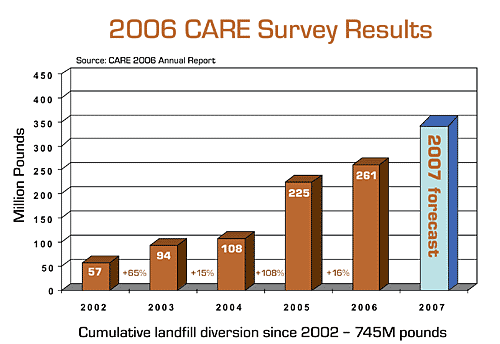New Standard Assures Sustainability in Carpets
Reclamation and End-of-Life Management
As premature replacement of carpet adds to the industry's environmental footprint, a key aspect of sustainability involves extending the product's life. Often, carpets are replaced not because they have worn out, but because
they no longer retain their original appearance. To protect against removal of carpet before the end of its useful life, the industry has established a program to enable consumers to identify vacuum cleaners and cleaning systems best suited to keeping carpets clean without putting dust back into the air. Identifying safe and effective chemicals to clean carpets is another industry concern, and a more recent program identifies effective and environmentally sound carpet spot removal cleaning products, as well as pre-spray and in-tank products.
To further reduce the overall environmental impact of carpet, the carpet industry is voluntarily recycling old carpet materials back into production of new carpets, as well as recycling it into alternative uses -everything from building materials to auto parts. The tasks of collecting, sorting and transporting used carpet are being addressed by carpet and fiber companies and individual entrepreneurs. A number of carpet companies have collection sites in place and are developing the means to separate carpet components and recover polymers. The industry is working toward recycling Nylon 6 and Nylon 6,6 fiber back into fiber. Both forms of nylon find widespread use in commercial carpets today. Some companies are refurbishing used carpet modules. Currently, billions of polyethylene terephthalate (PET) plastic beverage bottles are used each year to make polyester carpet fibers.
Â
Â
|
Â
"In this area the key question facing the carpet industry is how to make a product that has the fewest environmental impacts and a useful path at the end of its life. You have to begin with the end in mind," says Frank Endrenyi, Vice President of Sustainable Development for Mohawk Industries, Calhoun, Georgia, a producer and distributor of flooring worldwide, noting that there is substantial research being done among carpet industry companies on this issue. "If you make it, you eventually have to replace it. Some raw materials are easier to recycle back into carpet or other products than others."
One of the leading programs in carpet recycling is the Carpet America Recovery Effort (CARE), a joint industry-government non-profit effort to increase the amount of recycling and reuse of post-consumer carpet and to reduce the amount of waste carpet going to landfills. CARE was established as a result of a Memorandum of Understanding for Carpet Stewardship, a national agreement signed by members of the carpet industry, representatives of government agencies at the federal, state and local levels, and non-governmental organizations. CARE reports that of the approximately 5 billion pounds of carpet that was discarded in 2006, 261 million pounds of post-consumer carpet were diverted from landfills with 240 million pounds recycled- that is a 16 percent increase in diversion and a 23 percent increase in recycling from the previous year. As of September 1, 2007, there are 54 centers around the United States for the collection of post- consumer carpet. The CARE website includes a comprehensive listing of carpet recycling programs, as well as information on market and product development for recycled carpet and information on other end-of-life options. It is worth noting that for maximum assurance, recovery-recycling requirements should be spelled out in the purchase contract. Waiting to address end-of-life issues until the need arises can result in more limited options and higher costs.
Transportation
With raw materials and finished product shipping long distances,
transportation impacts should be considered. Many carpet industry companies have voluntarily adopted a range of efficiency measures from rolling, wrapping and compressing rugs for efficient shipping to adopting reusable or recyclable packaging and consolidating inbound shipments to maximize the use of trailers. It is a common practice for companies to use the largest possible container to reduce handling and maximize floor space, and products are frequently transported in dedicated tanks and trucks to eliminate entirely the need for packaging. The latest carpet tile technology has reduced the amount of raw material required and therefore transportation of less weight
has impacted the transportation of those products. New tiles have around 30 percent less weight than older technologies.
Indoor Air Quality
According to Dr. Robert Peoples, Director for Sustainability for the Carpet and Rug Institute, a misconception exists about indoor air quality concerns related to carpet. "Indoor air quality concerns are really
minimal when it comes to carpets, carpet backings, cushions and
adhesives that meet industry standards," says Peoples. "In fact, tested and certified carpet is one of the lowest emitting products that is put inside a building envelope. Most new interior furnishings and building materials emit VOCs for a period of time. Emissions from new carpet are among the lowest of any indoor furnishings, and most VOCs dissipate within 72 hours-even faster with good ventilation."
Recent studies indicate an improvement in indoor air quality when carpet is present. Carpet acts to "trap" dust and dirt until it can be removed by routine vacuuming. As opposed to a smooth floor covering, carpet benefits residents by holding or trapping dust and allergen particles so they won't be blown around in a room-and it is only airborne particles that affect allergic individuals.










